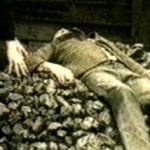 Technology
Technology  Technology
Technology  Humans
Humans 10 Everyday Human Behaviors That Are Actually Survival Instincts
 Animals
Animals 10 Animals That Humiliated and Harmed Historical Leaders
 History
History 10 Most Influential Protests in Modern History
 Creepy
Creepy 10 More Representations of Death from Myth, Legend, and Folktale
 Technology
Technology 10 Scientific Breakthroughs of 2025 That’ll Change Everything
 Our World
Our World 10 Ways Icelandic Culture Makes Other Countries Look Boring
 Misconceptions
Misconceptions 10 Common Misconceptions About the Victorian Era
 Mysteries
Mysteries 10 Strange Unexplained Mysteries of 2025
 Miscellaneous
Miscellaneous 10 of History’s Most Bell-Ringing Finishing Moves
 Technology
Technology Top 10 Everyday Tech Buzzwords That Hide a Darker Past
 Humans
Humans 10 Everyday Human Behaviors That Are Actually Survival Instincts
 Animals
Animals 10 Animals That Humiliated and Harmed Historical Leaders
Who's Behind Listverse?

Jamie Frater
Head Editor
Jamie founded Listverse due to an insatiable desire to share fascinating, obscure, and bizarre facts. He has been a guest speaker on numerous national radio and television stations and is a five time published author.
More About Us History
History 10 Most Influential Protests in Modern History
 Creepy
Creepy 10 More Representations of Death from Myth, Legend, and Folktale
 Technology
Technology 10 Scientific Breakthroughs of 2025 That’ll Change Everything
 Our World
Our World 10 Ways Icelandic Culture Makes Other Countries Look Boring
 Misconceptions
Misconceptions 10 Common Misconceptions About the Victorian Era
 Mysteries
Mysteries 10 Strange Unexplained Mysteries of 2025
 Miscellaneous
Miscellaneous 10 of History’s Most Bell-Ringing Finishing Moves
Ten Unsolved Mysteries of the Irish
Every March 17, not only do most people of Irish descent (and many who are not) pause to celebrate the life of the Emerald Isle’s patron saint, St. Patrick, but also it’s a time to take stock of the culture of Ireland on a day that is celebrated in more countries than any other national festival. There is much the world owes to the people of Ireland in terms of food, drink, and culture.
However, another legacy the country has is its unique history, which has spawned some of the greatest mysteries that have eluded scientists, historians, and criminal investigators for centuries. Enjoy this list of ten of the most intriguing mysteries of Ireland and its natives that have yet to be solved.
Related: Top 10 Irish Songs with Strange Origins
10 St. Brendan Discovers America
“In 1492, Columbus sailed the ocean blue.” He discovered America, and of course, the rest is history. Or is it? If you are a native of the Emerald Isle, then surely you know it wasn’t Christopher Columbus or 10th century Vikings who were the first Europeans to arrive in the Western Hemisphere. But rather, it was a 6th-century Irish monk who was a legendary seaman.
Known as “Brendan the Navigator” or more affectionately “St. Brendan” in Ireland, his seafaring exploits are chronicled in the 9th-century Navigatio Sancti Brendani Abbatis or “Voyage of St. Brendan the Abbot.” The “Navigatio” describes Brendan and his crew dodging floating “pillars of crystal” (possibly icebergs) before making landfall in a “promised land” that was so vast they failed to reach the far shore after “40 days of walking.” Could this have been the North American mainland?
In 1983, Harvard marine biologist Barry Fell discovered petroglyphs in West Virginia carved in Ogam script, the Irish alphabet used between the 6th and 8th centuries. Could St. Brendan and his men have left this? Most archeologists remained unconvinced. However, British author and adventurer Tim Severin built a replica of Brendan’s vessel and successfully completed what was believed to be the Irish monk’s route in 1977. But did St. Brendan do it? We may never know.[1]
9 The Murder of William Desmond Taylor
Few remember Irish-born filmmaker William Desmond Taylor today. With a filmography of over sixty movies, Taylor directed some of Hollywood’s biggest stars during the silent era, such as Mary Pickford and Wallace Reid. He was also a popular figure in Tinseltown who was linked romantically with one of the film industry’s biggest comedic stars, Mabel Normand. The dapper, 49-year-old Taylor was also stalked by his obsessed 17-year-old protégé, former child star Mary Miles Minter.
When Taylor was found shot dead in his upscale Los Angeles bungalow on the morning of February 2, 1922, there were many possible suspects. Could it have been the cocaine-addicted Normand, whom he was reportedly “deeply in love with” and trying to help shake her drug dependency? Or perhaps Minter, who supposedly refused to accept his rejection of her romantic advances? Or maybe Minter’s mother, Charlotte Shelby, who was a manipulative, overbearing stage mother, who may have been in love with Taylor herself? And last but not least, Taylor’s cook and valet Henry Peavey, who would die nine years later in an asylum of syphilis-related dementia, was strongly suspected.
Over a century later, his death remains an unsolved cold case that continues to puzzle police and historians to this day.[2]
8 The Abduction of Shergar
When the topic of the greatest racehorses of all time is brought up, most Americans think of Secretariat, Sea Biscuit, or the ageless John Henry. But for the Irish, one of the fastest thoroughbreds ever was the County Kildare-born stallion Shergar. Owned by the Aga Khan IV, Shergar enjoyed a dominant season in 1981, winning the 202nd Epsom Derby by ten lengths, and the Irish Sweeps Derby by four lengths.
Two years later, after being retired to Ballymany Stud, Shergar was stolen by an armed gang who demanded a ransom for the return of the prized racehorse. When the kidnappers could not provide proof that the horse was still alive four days later, negotiations ended, and Shergar was never returned.
In 1999, a former Irish Republican Army member claimed the IRA stole the horse to raise money for arms. He further claimed that after the abduction, Shergar panicked and seriously damaged his leg leading to the horse being destroyed. To date, no one has ever been arrested for the crime, and Shergar’s body has never been found. As a tribute to the famed thoroughbred, the Shergar Cup was inaugurated in 1999 to pay homage to the horse’s great accomplishments on the racetrack.[3]
7 The Tragedy of Aer Lingus Flight 712
On the morning of March 24, 1968, Irish Aer Lingus Flight 712 departed from Cork en route to London with 61 passengers and crew on board. After a normal takeoff, flight controllers received a call believed to convey the message that the plane was flying at “12,000 feet, descending, spinning rapidly.” (LINK #12) By noon, Flight 712 had disappeared. After failed attempts to contact the pilot, Captain Bernard O’Beirne, the London Air Traffic Control immediately called for a search of the area west of Strumble Head off the coast of Wales.
After futile efforts to locate the plane, the wreckage was discovered, and bodies sighted northeast of Tuskar Rock, off the southeast coast of County Wexford, Ireland. Although only fourteen bodies were later recovered, there were no survivors of Flight 712. Several theories have been proposed as to the cause of the tragic flight, from a bird strike to a structural failure with the plane itself or possibly a target drone accidentally deployed by the nearby Aberporth missile station. Although a two-year investigation into the crash was conducted, including a 2002 review process by the Irish Air Accident Investigation Unit, a cause for the crash has yet to be determined.[4]
6 The Disappearance of Amy Fitzpatrick
Fifteen-year-old Amy Fitzpatrick was a Dublin, Ireland, native living abroad in Málaga, Spain, with her family on New Year’s Day 2008. She spent that evening babysitting the brother of her friend Ashley Rose. When she left that night to return to her own home, which was only a short walk away, she mysteriously disappeared and was never seen or heard from again. A massive search was undertaken to find the missing Irish teenager but investigators failed to find any evidence of her whereabouts.
In June of 2009, Fitzpatrick’s mother received an anonymous phone call from a man who claimed that Amy had been kidnapped and was alive in Madrid. The same man later sent a text requesting a ransom of 500,000 euros. Both the call and text were determined to be from pre-paid phones. Later, authorities and private investigators failed to locate the mysterious caller or determine if his story was even true. Five years after Amy’s disappearance, her 23-year-old brother Dean was stabbed to death in Dublin in an incident later ruled to be manslaughter. Who was the perpetrator? None other than Amy’s mother’s boyfriend, Dave Mahon, who lived with the Fitzpatricks at the time of Amy’s disappearance, thus adding another twist to a cold case that has yet to be solved.[5]
5 The Extinction of the Irish Elk
What is the largest member of the deer family that ever existed? Is it the Alaskan moose, which can grow up to two meters (6.5 feet) tall from hoof to shoulder while weighing in at a massive 1800 pounds? (LINK #18) Close, but not quite. The Irish elk, a giant Ice Age megaloceros whose range extended from Ireland to Lake Baikal in Siberia, stood an imposing 2.2 meters (7 feet) tall at the shoulders with 90-pound antlers that spanned up to 3.6 meters (12 feet). It is generally considered to be the largest deer that ever existed.
However, sadly, these majestic beasts disappeared nearly 8,000 years ago, with the most recent skeletal remains of the species limited to what is today Western Russia. Why did the Irish elk become extinct? Named for the abundant fossils of the elk found in Irish bogs, there have been many hypotheses put forth for the species’ demise.
The most obvious is the elks’ inability to adapt to the extreme climate change of the most recent ice age. Overhunting by early humans is another possibility, and here’s an intriguing one, the inability of stags to escape to forested areas from predators due to their oversized antlers. With rumors abound that modern scientists plan to clone and bring back the Irish elk, maybe its return from extinction will provide some clues.[6]
4 The Origin of the Blarney Stone
For the introverted among us, the Irish have two possible options to loosen the tongue and endow a lass or bloke with the “gift of gab.” One option is to drink a pint of Guinness. If that doesn’t work, according to legend, kissing the Blarney Stone is a sure-fire guarantee to give one the eloquence of speech and wit they desire. But what exactly is the Blarney Stone?
Technically it’s a block of limestone built into the battlements high atop Blarney Castle near Cork, Ireland. Its origin is the stuff of legends such as one that the builder of the castle, Cormac Laidir MacCarthy, was told by the Irish goddess Cliodhna to kiss the first stone he should find on his way to court. In doing so, it gave him the verbal power of persuasion to win his case. He supposedly then placed the stone in the castle parapet.
In reality, no one really knows where the stone came from. But if Ireland is too far to travel to see it, Texas Tech University in Lubbock claims a rock fragment on display outside the old Electrical Engineering Building is a missing piece of the Blarney Stone. However, according to their legend, only Texas Tech graduating seniors that kiss the stone upon graduation receive the gift of eloquence.[7]
3 The Banishment of Snakes
If you suffer from ophidiophobia, you are not alone. Roughly one-half of the U.S. population suffers from the malady, better known as “fear of snakes.” If your greatest hope is to move to a country where snakes don’t exist, you have three options: Iceland, New Zealand, and yes, the Emerald Isle. According to legend, St. Patrick himself banished the slithery reptiles from Ireland in the 5th century, chasing them into the sea after attacking him during a 40-day fast.
Countering the claim, modern science claims snakes never existed in Ireland at all. In fact, there is no evidence of any reptiles in post-glacial Ireland, with the exception of the viviparous or common lizard, which is common to the island. So why is Ireland only one of three countries free of the reptile most likely to instill fear in one out of every two people? The general rationale is that Ireland is simply too cold and inhospitable for cold-blooded reptiles to survive. That being said, snakes do exist in neighboring England and Scotland, where the climate is similar. So if you’re like Indiana Jones and hate snakes, it’s okay to go ahead and lift a pint to St. Patrick on March 17. Let the science be damned.[8]
2 The Fate of Francis Crozier
On the morning of May 19, 1845, two ships, the HMS Erebus and the HMS Terror, set sail from England for the Canadian Arctic, searching for the fabled Northwest Passage. Led by the 59-year-old Sir John Franklin, both ships and a crew of 128 other men were last sighted by whalers off the west coast of Greenland in July of that summer. Their countrymen would never see them again.
Second in command to Franklin was a seasoned naval officer of humble birth, Irish Captain Francis Crozier. Two years into the voyage, Franklin died, and both ships became trapped in the pack ice off the west coast of King William Island. The task of leading the men out of their frozen arctic trap was left to Crozier. But what happened to the men would remain unknown for another fourteen years.
A terse note found in a cairn on King William Island in 1859 revealed the men’s desperate trek to the Canadian mainland. They would never make it, and their demise has been attributed to everything from hypothermia, scurvy, and starvation to lead poisoning from poorly soldered tins of canned meat. (LINK #32) When, where, and how Francis Crozier died remains a mystery. Today the Irish seaman is perhaps best known as the protagonist of Dan Simmons’ best-selling novel The Terror and the 2018 AMC television series adapted from the book and inspired by the tragedy.[9]
1 St. Patrick’s Grave
Also known as the “Apostle of Ireland,” Patrick is the patron saint of all things Irish. Although specific dates of his birth and death are difficult to determine with absolute certainty, it is generally accepted as fact that St. Patrick lived and was an active Christian missionary during the fifth century. What is more difficult to pinpoint is the actual location where the venerated Irish saint is actually buried.
It is claimed that St. Patrick is buried on the grounds of Down Cathedral, located in the town of Down Patrick in Northern Ireland. Meanwhile, the medieval monks of Glastonbury Abbey in Somerset, England, claimed that St. Patrick was buried there. According to their tradition, after Patrick completed his tenure as Bishop of Ireland, he retired to Glastonbury Abbey, becoming the monastery’s first Abbot. They further claim he is interred next to the High Altar in the “Old Wattle Chapel.”
What is known is that the patron saint of Ireland was born in Roman-occupied Britain, which makes the claims that St. Patrick returned to the land of his birth not as far-fetched as it seems. (LINK #37) To cover your bases for St. Patrick’s Day this year, feel free to tint your English brown ale green.[10]








